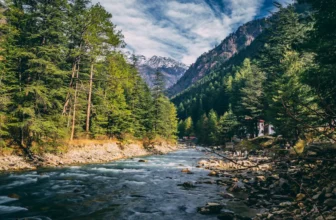
Introduction to Trekking Trails;
Trekking routes provide an exciting and absorbing approach to discover the natural beauty and cultural diversity of many locations across the world.
Trekking paths provide an opportunity to connect with nature, challenge yourself physically and emotionally, and experience the joy of discovery, whether you’re an experienced hiker or a beginner.
Trekking entails travelling on well-defined pathways through a variety of terrains, including forests, mountains, valleys, deserts, and even coastal locations. These paths can range from moderate family hikes to difficult ones requiring advanced hiking skills and fitness levels.
Trekking trails frequently lead to breathtaking views, hidden gems, and secluded settlements that would otherwise be unreachable by automobile.
The following are important elements of trekking trails:
- Difficulty Levels
- Scenic Beauty
- Cultural Immersion
- Adventure and Exploration
- Physical and Mental Fitness
- Minimal Environmental Impact
- Equipment and Preparation
Finally, trekking routes are an interesting way to discover nature, push oneself, and interact with people from diverse cultures. There’s probably a trekking trail out there that meets your interests and talents, whether you’re looking for a peaceful walk or an adrenaline-fueled adventure.
Overview of Everest Base Camp Trek;
Depending on the itinerary and acclimatisation pauses, the Everest Base Camp Trek normally takes 12 to 14 days to complete. The trek typically begins and concludes in Lukla, a little town with a one-of-a-kind airport that serves as the entry to the Everest region.
Trekkers leave Lukla on a trail that takes them through lovely villages, suspension bridges, and lush forests.
Highlights:
- The walk begins with a visit to the Sagarmatha National Park, a UNESCO World Heritage Site known for its diverse flora and fauna, which includes rare species such as the elusive snow leopard and colourful pheasants.
- A vital acclimatisation stop, this lively Sherpa town. It’s an excellent site to learn about local culture, buy trekking equipment, and gaze out over Everest and its neighbouring peaks.
- Located along the trail, Tengboche Monastery is a calm and attractive Buddhist monastery with panoramic views of Everest and the surrounding peaks.
- These villages offer additional possibilities to acclimatise to high altitude, connect with local residents, and enjoy breathtaking mountain views.
- This viewpoint provides one of the best panoramic views of Everest as well as adjacent peaks such as Lhotse and Nuptse. Many hikers come to Kala Patthar in the early morning to see the sunrise over the Himalayas.
- The trek’s ultimate objective, Everest Base Camp, is located at an elevation of approximately 5,364 metres (17,598 feet). While this is not the pinnacle of Everest, it allows hikers to stand at the foot of the world’s highest mountain and experience the unique ambience of the base camp during the climbing season.
Challenges:
The Everest Base Camp Trek is difficult, owing to the high altitude and fluctuating weather conditions. Acclimatisation is essential for reducing the risk of altitude sickness. The trail also includes high ascents and descents, as well as crossing suspension bridges and difficult terrain.
Preparation is essential for a successful Everest Base Camp Trek. This includes obtaining the right permissions, hiring a local guide or porter if wanted, packing adequate clothing and equipment for the varied weather conditions, and being physically fit for the trek’s demands.
The Everest Base Camp Trek is a once-in-a-lifetime adventure that blends breathtaking natural beauty, cultural exploration, and personal success. It’s an opportunity to tread in the footsteps of renowned mountaineers and gain firsthand knowledge.
Overview of Manaslu Base Camp Trek ;
The Manaslu Base Camp Trek is a compelling and less-travelled trekking path that takes you through Nepal’s magnificent scenery and secluded settlements.
This journey offers a once-in-a-lifetime opportunity to discover the region’s cultural riches while taking in stunning views of Mount Manaslu, the world’s eighth-highest peak.
Duration and Route: Depending on the schedule and acclimatisation pauses, the Manaslu Base Camp Trek normally takes 14 to 18 days to complete. The journey circles Mount Manaslu, giving hikers the opportunity to see a range of terrains and immerse themselves in local culture.
Highlights:
- The trail passes through a variety of environments, from lush forests and terraced fields to alpine meadows and harsh terrain. The changing environment adds to the trek’s allure.
- The trail follows the Budhi Gandaki River, passing it via suspension bridges multiple times. The river is flanked by spectacular gorges and waterfalls, making for a scenic ride.
- Along the trek, you’ll come across traditional villages inhabited by several ethnic groups such as the Gurungs, Tamangs, and Tibetans. This allows you to learn about their distinct cultures, traditions, and lives.
- At an elevation of roughly 5,160 metres (16,930 feet), this pass is one of the trek’s highlights. Crossing the pass provides panoramic views of the area.
The Manaslu Base Camp Trek entails trekking at high altitudes, which necessitates adequate acclimatisation. The Larkya La Pass can be tough due to its elevation and the possibility of snow and bad weather. Trekkers should expect several long and tough days on the trail.
Preparation:
Planning ahead of time is essential for a successful Manaslu Base Camp Trek. Obtaining the right permissions, hiring a guide or porter, packing appropriate clothing and gear for varying weather conditions, and being physically fit to manage the rigours of the trek are all part of this.
In comparison to other popular trekking routes in Nepal, the Manaslu Base Camp Trek provides a more off-the-beaten-path experience. It’s a terrific opportunity to interact with nature, learn about local cultures, and see the beauty of the world.
Overview of Langtang Valley Trek;
The Langtang Valley Trek is a popular and easily accessible trekking route in Nepal, providing a very short but incredibly diversified tour across the Langtang region.
This journey is well-known for its beautiful scenery, attractive villages, and the chance to experience the warm hospitality of the local Tamang and Sherpa populations.
The Langtang Valley Trek typically takes 8 to 10 days to complete, making it an excellent choice for trekkers with limited time but a desire to enjoy the beauty of the Himalayas.
The walk starts in Syabrubesi and follows the Langtang River through villages and lush woods until arriving at the high alpine sceneries around Kyanjin Gompa.
Highlights:
- The trail visits traditional Tamang and Sherpa communities, providing insights into their cultures, livelihoods, and daily activities. You may talk to the nice inhabitants and learn about their customs.
- At roughly 3,870 metres (12,700 feet), this little village serves as the trek’s highest point. It is home to the Kyanjin Gompa monastery, which provides panoramic views of the surrounding peaks.
- A popular day trip from Kyanjin Gompa, Tserko Ri is a viewpoint that offers spectacular views.
Challenges:
While the Langtang Valley Trek is rated as a moderate trek, it does include trekking at higher altitudes. Acclimatisation is essential, as is being prepared for shifting weather conditions. There are some hilly stretches, river crossings, and potentially hazardous terrain on the trail.
Permits and Regulations:
As with other trekking sites in Nepal, trekkers must get permits to enter Langtang National Park. These permissions can be obtained in Kathmandu or in Syabrubesi upon arrival.
Preparation for the Langtang Valley walk entails obtaining the necessary permits, engaging a local guide if requested, packing adequate clothing and equipment for the walk, and being in generally excellent physical condition.
The Langtang Valley Trek is a fantastic choice for trekkers who want to explore the splendour of the Langtang Valley.
Conclusion
Trekking is an enthralling journey that lets you discover some of the most stunning landscapes on the planet, connect with other cultures, and test your physical and mental boundaries.
Trekking provides a unique opportunity to explore nature’s beauties up close, whether you’re conquering high mountain ranges, meandering through lush woods, or through alpine meadows.
There is a trekking track for every level of expertise and fitness, from the high peaks of the Himalayas to the rocky trails of national parks and the calm walks of coastal areas.
If you are planning to visit Nepal for any adventure activities in Nepal contact a local travel company Nepal High Trek & Expedition Pvt. Ltd for any packages or information. Contact us for further details via Email: info@nepalhightrek.com, WhatsApp: +977-9851142116






